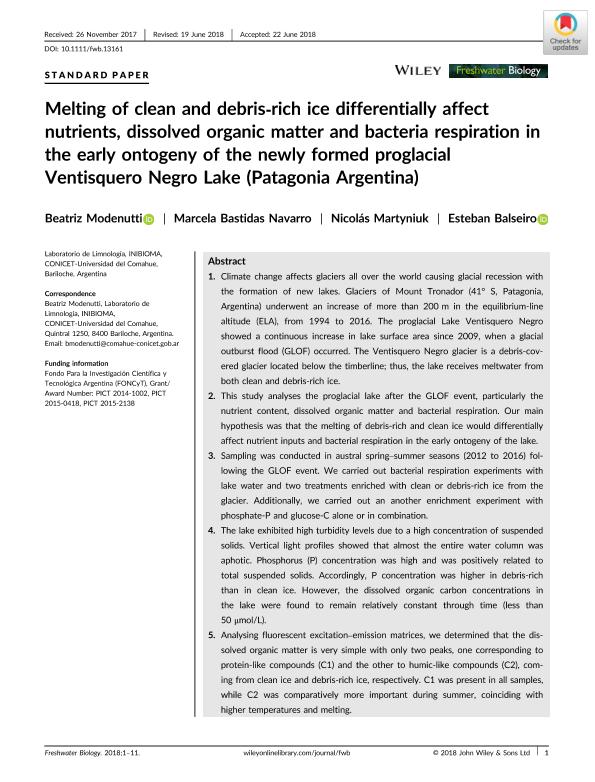Mostrar el registro sencillo del ítem
dc.contributor.author
Modenutti, Beatriz Estela

dc.contributor.author
Bastidas Navarro, Marcela Alejandra

dc.contributor.author
Martyniuk, Nicolás Alejandro

dc.contributor.author
Balseiro, Esteban Gabriel

dc.date.available
2019-11-26T21:13:37Z
dc.date.issued
2018-11
dc.identifier.citation
Modenutti, Beatriz Estela; Bastidas Navarro, Marcela Alejandra; Martyniuk, Nicolás Alejandro; Balseiro, Esteban Gabriel; Melting of clean and debris-rich ice differentially affect nutrients, dissolved organic matter and bacteria respiration in the early ontogeny of the newly formed proglacial Ventisquero Negro Lake (Patagonia Argentina); Wiley Blackwell Publishing, Inc; Freshwater Biology (print); 63; 11; 11-2018; 1341-1351
dc.identifier.issn
0046-5070
dc.identifier.uri
http://hdl.handle.net/11336/90588
dc.description.abstract
Climate change affects glaciers all over the world causing glacial recession with the formation of new lakes. Glaciers of Mount Tronador (41° S, Patagonia, Argentina) underwent an increase of more than 200 m in the equilibrium-line altitude (ELA), from 1994 to 2016. The proglacial Lake Ventisquero Negro showed a continuous increase in lake surface area since 2009, when a glacial outburst flood (GLOF) occurred. The Ventisquero Negro glacier is a debris-covered glacier located below the timberline; thus, the lake receives meltwater from both clean and debris-rich ice. This study analyses the proglacial lake after the GLOF event, particularly the nutrient content, dissolved organic matter and bacterial respiration. Our main hypothesis was that the melting of debris-rich and clean ice would differentially affect nutrient inputs and bacterial respiration in the early ontogeny of the lake. Sampling was conducted in austral spring–summer seasons (2012 to 2016) following the GLOF event. We carried out bacterial respiration experiments with lake water and two treatments enriched with clean or debris-rich ice from the glacier. Additionally, we carried out an another enrichment experiment with phosphate-P and glucose-C alone or in combination. The lake exhibited high turbidity levels due to a high concentration of suspended solids. Vertical light profiles showed that almost the entire water column was aphotic. Phosphorus (P) concentration was high and was positively related to total suspended solids. Accordingly, P concentration was higher in debris-rich than in clean ice. However, the dissolved organic carbon concentrations in the lake were found to remain relatively constant through time (less than 50 μmol/L). Analysing fluorescent excitation–emission matrices, we determined that the dissolved organic matter is very simple with only two peaks, one corresponding to protein-like compounds (C1) and the other to humic-like compounds (C2), coming from clean ice and debris-rich ice, respectively. C1 was present in all samples, while C2 was comparatively more important during summer, coinciding with higher temperatures and melting. This study supports the hypothesis that melting of clean and debris-rich ice would affect DOM and P input at early stages of a proglacial lake formed by the recession of a debris-covered glacier. Bacterial respiration was observed to be positively affected by debris-rich ice melting and to be P limited. Thus, P is a major controlling factor for carbon dynamics in a newly formed proglacial lake.
dc.format
application/pdf
dc.language.iso
eng
dc.publisher
Wiley Blackwell Publishing, Inc

dc.rights
info:eu-repo/semantics/openAccess
dc.rights.uri
https://creativecommons.org/licenses/by-nc-sa/2.5/ar/
dc.subject
BACTERIAL RESPIRATION
dc.subject
DISSOLVED NUTRIENTS
dc.subject
FLUORESCENCE MATRICES
dc.subject
GLACIAL LAKE
dc.subject
GLACIAL RECESSION
dc.subject.classification
Ecología

dc.subject.classification
Ciencias Biológicas

dc.subject.classification
CIENCIAS NATURALES Y EXACTAS

dc.title
Melting of clean and debris-rich ice differentially affect nutrients, dissolved organic matter and bacteria respiration in the early ontogeny of the newly formed proglacial Ventisquero Negro Lake (Patagonia Argentina)
dc.type
info:eu-repo/semantics/article
dc.type
info:ar-repo/semantics/artículo
dc.type
info:eu-repo/semantics/publishedVersion
dc.date.updated
2019-10-10T13:54:12Z
dc.journal.volume
63
dc.journal.number
11
dc.journal.pagination
1341-1351
dc.journal.pais
Reino Unido

dc.journal.ciudad
Londres
dc.description.fil
Fil: Modenutti, Beatriz Estela. Consejo Nacional de Investigaciones Científicas y Técnicas. Centro Científico Tecnológico Conicet - Patagonia Norte. Instituto de Investigaciones en Biodiversidad y Medioambiente. Universidad Nacional del Comahue. Centro Regional Universidad Bariloche. Instituto de Investigaciones en Biodiversidad y Medioambiente; Argentina
dc.description.fil
Fil: Bastidas Navarro, Marcela Alejandra. Consejo Nacional de Investigaciones Científicas y Técnicas. Centro Científico Tecnológico Conicet - Patagonia Norte. Instituto de Investigaciones en Biodiversidad y Medioambiente. Universidad Nacional del Comahue. Centro Regional Universidad Bariloche. Instituto de Investigaciones en Biodiversidad y Medioambiente; Argentina
dc.description.fil
Fil: Martyniuk, Nicolás Alejandro. Consejo Nacional de Investigaciones Científicas y Técnicas. Centro Científico Tecnológico Conicet - Patagonia Norte. Instituto de Investigaciones en Biodiversidad y Medioambiente. Universidad Nacional del Comahue. Centro Regional Universidad Bariloche. Instituto de Investigaciones en Biodiversidad y Medioambiente; Argentina
dc.description.fil
Fil: Balseiro, Esteban Gabriel. Consejo Nacional de Investigaciones Científicas y Técnicas. Centro Científico Tecnológico Conicet - Patagonia Norte. Instituto de Investigaciones en Biodiversidad y Medioambiente. Universidad Nacional del Comahue. Centro Regional Universidad Bariloche. Instituto de Investigaciones en Biodiversidad y Medioambiente; Argentina
dc.journal.title
Freshwater Biology (print)

dc.relation.alternativeid
info:eu-repo/semantics/altIdentifier/doi/http://dx.doi.org/10.1111/fwb.13161
dc.relation.alternativeid
info:eu-repo/semantics/altIdentifier/url/https://onlinelibrary.wiley.com/doi/abs/10.1111/fwb.13161
Archivos asociados
